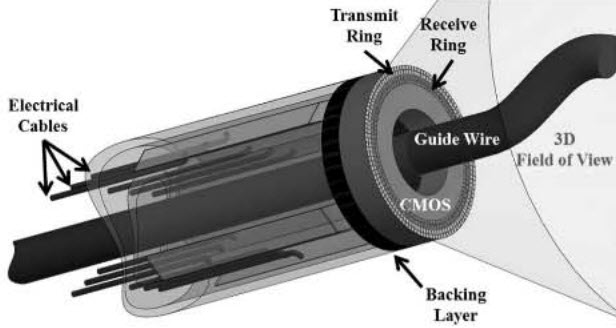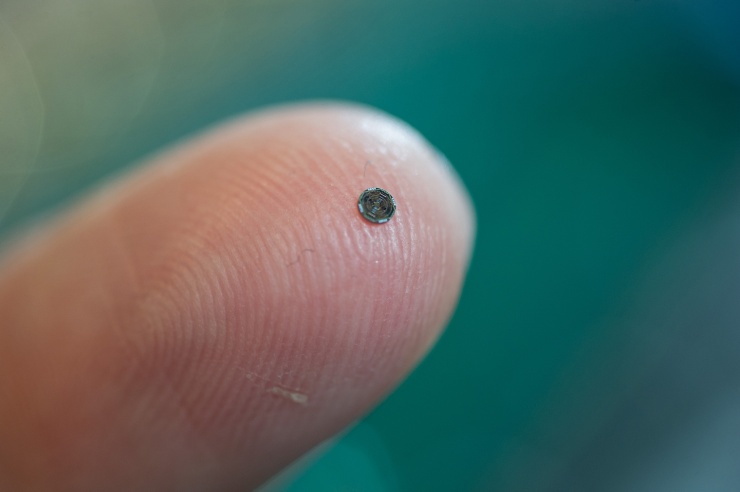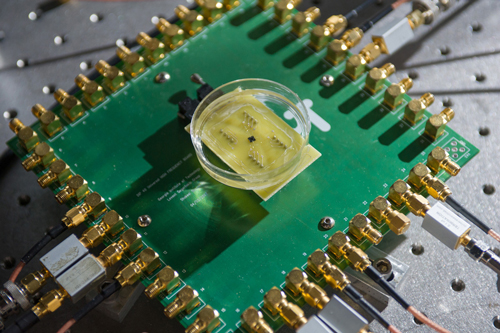Single-chip device to provide real-time ultrasonic 3D images from inside the heart and blood vessels
February 24, 2014

Concept drawing for a single-chip catheter-based device that would provide forward-looking, real-time, three-dimensional imaging from inside the heart, coronary arteries, and peripheral blood vessels (credit: Gokce Gurun et al./IEEE Transactions on Ultrasonics, Ferroelectrics and Frequency Control)
The technology for a device that would provide real-time 3D imaging from inside the heart, coronary arteries, and peripheral blood vessels has been developed by Georgia Institute of Technology researchers.
With its volumetric imaging, the new device could better guide surgeons working in the heart and allow more of patients’ clogged arteries to be cleared without major surgery.
The device integrates ultrasound transducers with processing electronics on a single 1.4 millimeter CMOS silicon chip. On-chip processing of signals allows data from more than a hundred elements on the device to be transmitted using just 13 tiny cables, permitting it to easily travel through circuitous blood vessels. The forward-looking images produced by the device would provide significantly more information than existing cross-sectional ultrasound.
A 3D view of blood vessels
“Our device will allow doctors to see the whole volume that is in front of them within a blood vessel,” said F. Levent Degertekin, a professor in the George W. Woodruff School of Mechanical Engineering at the Georgia Institute of Technology. “This will give cardiologists the equivalent of a flashlight so they can see blockages ahead of them in occluded arteries. It has the potential for reducing the amount of surgery that must be done to clear these vessels.”

A single-chip catheter-based device that would provide forward-looking, real-time, three-dimensional imaging from inside the heart, coronary arteries and peripheral blood vessels is shown on the tip of a finger (credit: Georgia Tech Photo, Rob Felt)
“If you’re a doctor, you want to see what is going on inside the arteries and inside the heart, but most of the devices being used for this today provide only cross-sectional images,” Degertekin explained.
“If you have an artery that is totally blocked, for example, you need to see the front, back and sidewalls altogether. That kind of information is basically not available at this time.”
The single chip device combines capacitive micromachined ultrasonic transducer (CMUT) arrays with front-end CMOS electronics technology to provide three-dimensional intravascular ultrasound (IVUS) and intracardiac echography (ICE) images.
Ultrasonic imaging and transmission system in a device just 1.5 millimeters in diameter
The dual-ring array includes 56 ultrasound transmit elements and 48 receive elements. When assembled, the donut-shaped array is just 1.5 millimeters in diameter, with a 430-micron center hole to accommodate a guide wire.
Power-saving circuitry in the array shuts down sensors when they are not needed, allowing the device to operate with just 20 milliwatts of power, reducing the amount of heat generated inside the body. The ultrasound transducers operate at a frequency of 20 megahertz (MHz).
Imaging devices operating within blood vessels can provide higher-resolution images than devices used from outside the body because they can operate at higher ultrasonic frequencies. But operating inside blood vessels requires devices that are small and flexible enough to travel through the circulatory system. They must also be able to operate in blood.
Doing that requires a large number of elements to transmit and receive the ultrasound information. Transmitting data from these elements to external processing equipment could require many cable connections, potentially limiting the device’s ability to be threaded inside the body.
Degertekin and his collaborators addressed that challenge by miniaturizing the elements and carrying out some of the processing on the probe itself, allowing them to obtain what they believe are clinically useful images with only 13 cables.
“You want the most compact and flexible catheter possible,” Degertekin explained. “We could not do that without integrating the electronics and the imaging array on the same chip.”
Animal trials next
Researchers have developed and tested a prototype able to provide image data at 60 frames per second. The researchers expect to conduct animal trials to demonstrate the device’s potential applications. They ultimately expect to license the technology to an established medical diagnostic firm to conduct the clinical trials necessary to obtain FDA approval.
For the future, Degertekin hopes to develop a version of the device that could guide interventions in the heart under magnetic resonance imaging (MRI). Other plans include further reducing the size of the device to place it on a 400-micron diameter guide wire.
Details of the research were published online in the February 2014 issue of the journal IEEE Transactions on Ultrasonics, Ferroelectrics and Frequency Control. Research leading to the device development was supported by the National Institute of Biomedical Imaging and Bioengineering (NIBIB), part of the National Institutes of Health.
An Istanbul Technical University researcher was also involved. The research was supported by award number R01EB010070 from the National Institute of Biomedical Imaging and Bioengineering (NIBIB), part of the National Institutes of Health (NIH).
Abstract of IEEE Transactions on Ultrasonics, Ferroelectrics and Frequency Control paper
Intravascular ultrasound (IVUS) and intracardiac echography (ICE) catheters with real-time volumetric ultrasound imaging capability can provide unique benefits to many interventional procedures used in the diagnosis and treatment of coronary and structural heart diseases. Integration of capacitive micromachined ultrasonic transducer (CMUT) arrays with front-end electronics in single-chip configuration allows for implementation of such catheter probes with reduced interconnect complexity, miniaturization, and high mechanical flexibility. We implemented a single-chip forward-looking (FL) ultrasound imaging system by fabricating a 1.4-mm-diameter dual-ring CMUT array using CMUT-on-CMOS technology on a front-end IC implemented in 0.35-μm CMOS process. The dual-ring array has 56 transmit elements and 48 receive elements on two separate concentric annular rings. The IC incorporates a 25-V pulser for each transmitter and a low-noise capacitive transimpedance amplifier (TIA) for each receiver, along with digital control and smart power management. The final shape of the silicon chip is a 1.5-mm-diameter donut with a 430-μm center hole for a guide wire. The overall front-end system requires only 13 external connections and provides 4 parallel RF outputs while consuming an average power of 20 mW. We measured RF A-scans from the integrated single- chip array which show full functionality at 20.1 MHz with 43% fractional bandwidth. We also tested and demonstrated the image quality of the system on a wire phantom and an ex vivo chicken heart sample. The measured axial and lateral point resolutions are 92 μm and 251 μm, respectively. We successfully acquired volumetric imaging data from the ex vivo chicken heart at 60 frames per second without any signal averaging. These demonstrative results indicate that single-chip CMUT-on-CMOS systems have the potential to produce realtime volumetric images with image quality and speed suitable for catheter-bas- d clinical applications.
